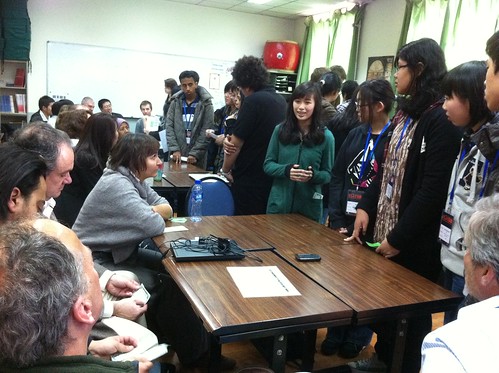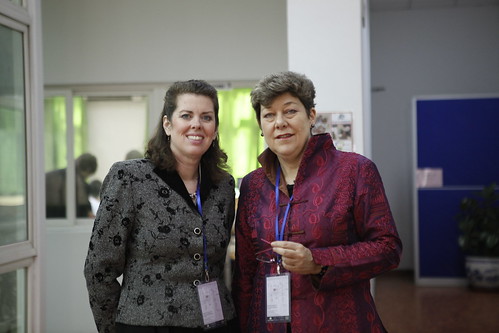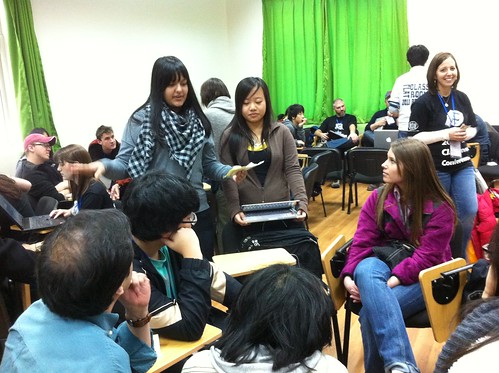Last weekend I had the privilege of working with Julie and Vicki (and Andrew, Bernajean, Frank, Simon, Madeleine, Ann, Billy, Tom, Steve and the amazing UNI “Panthers” team) at the second Flat Classroom Conference at Beijing BISS International School in Beijing (pictures here, tweets here: #flatclass2011).
Although there were a number of challenges, I continue to believe that this is the future of conferences. Let me tell you why:
It’s the students: The most amazing thing about this conference is that there are an equal number of students and adults (this time around we had 100 students and 100 adults!). How often do we sit in the same room with students from various schools as our peers, learning, thinking and exploring together? The energy in a room full of teachers and students collaborating is phenomenal. This is the kind of environment we need to be cultivating. Not teachers talking about what we should do with students. Just doing it. Together.
It’s the action: Both the student and leadership strand focus on actually producing something during the 3 days of the conference. The students develop a solution to a global problem (this time we focused on the environment and challenges of urban living) and the teachers develop a globally collaborative project they can implement in their schools. Both teacher and student projects are shared with all of the attendees and “judged” to provide authentic and timely feedback.
It’s the leadership: Everyone at this conference is walking the talk. Almost every presenter or leader at this conference is actively engaged in working with students on a daily basis. They all have real-world, everyday, practical tips for making global collaboration happen. Although we may have very specific views on what should happen in the classroom, we’re all actually working to make it happen – not just talking about it.
It’s the flexibility: Even though Julie and Vicki planned each day to the minute, they were always ready to take suggestions, accomodate for the needs of the participants, and generally completely mix things up at needed. The ability to go with the flow and make sure things are working for all involved (although it entails some long hours) helps ensure that everyone’s (facilitators and participants alike) needs are met.
It’s the approach: Facilitating at this conference is pretty much just like the way I teach. I love being in a room full of students and teachers engaged in their work, I love seeing their ownership over their process and product, and I love seeing how much they can learn in such a short time. This is why we’re teachers – our conferences should reflect the structure and environment we strive to create in our own classrooms.
I am so fortunate to have been involved in this experience (not just a conference) for the second time. The first time was in a workshop format (basically the same thing, only smaller), and in comparing the two, I see a few areas for improvement:
Cohorts not Strands: During the conference we had a Student Summit (all of the students working in teams together) and a Leadership Summit (all of the adults working in teams together). Although the strands crossed paths several times for the pitching (2 rounds of students pitching to adults and 1 round of adults pitching to students) and the Web 2.0 Elevator Speeches, I think we were too separate. It was easy to see that the highlight of the conference for everyone was in those mixed-Summit groups.
So, as Julie suggested in a “debriefing” session in Beijing, if we can split the attendees into cohorts, mixed student and teacher, I think we’ll get that amazing glow and energy the whole time. Just because we’re in the same room doesn’t mean we can’t be doing two slightly different things, but physically being in the same space makes a big difference.
More Time: I know this is always going to be a wish, no matter how many days we get, but I think just one more full afternoon will make a big difference. The students were introduced to the format, concept and goals of the conference in one very short evening session where they were given only about 20 minutes to get to know their teammates and brainstorm possible projects.
If we could extend that time a bit for students so we can be more clear in exactly what the end product will be and we can facilitate a more in-depth team-building activity, I think it would make a huge difference. At the same time, we could also have the teachers go through some specific tool-based sessions so they are ready to go with their projects the following day. A little bit of extra time spent getting the practicals under way will make a big difference in the teachers productivity the following day.
Structured Planning for Presenters: One thing I loved about Learning 2.010 this year was that we had one full day before the conference started to plan together as presenters. Considering we were all coming from different parts of the world and not everyone had worked together before (let alone met each other), it was so helpful to have that very structured time set aside for planning. Of course, not everything gets done in one day, but all of the specifics can be nailed down and a really cohesive workshop can be developed.
Final Thoughts
I really am honored to be able to participate in these Flat Classroom events. Even with the variety of challenges (hello, a conference supported by web 2.0 tools hosted in China?) we faced, it is always an amazing opportunity to learn and collaborate with some absolutely amazing people. Not only was it fantastic to be facilitating with all those geniuses listed above, but I also finally (finally!) got to meet Dave Truss before he leaves Asia, and spend a little bit of time with Colin, Ann, Heather, John, the fabulous BISS staff, and some great friends from ISB: Margherite and Martin.
If the power of conferencing is in the networking and the collaboration, for us as adults, won’t it be the same for our students? I sure hope we see more experiences like this focusing on bringing together teachers and students in a project-based, technology-rich environment.
What do you think? Have you attended similar events? How were they more or less valuable than teacher-only conferences?
Image Credits
- Planning on Flickr by superkimbo
- First Student Pitch on Flickr by superkimbo
- Julie & Vicki on Flickr by Julie Lindsay
- Planning on Flickr by superkimbo
- Web 2.0 Elevator Speech on Flickr by superkimbo










Kim,
These thoughts mirror precisely what I have been raving to my colleagues here in Yangon about the weekend at FlatClassroom. It is the future of PD for me.
Of the many things that impressed me was the final day when the students shared their lasting memories. Not one of them spoke about the technology, rather it was the connections with new friends, new ideas and new cultures that had the greatest impact on each of them. What a wonderful rebuttal to those who lament that students are becoming too absorbed in their screens.
Related to this is my very strong impression that for the students the technology was just part of the furniture like the chairs and tables they used- no big deal. But for so many of us teachers the technology is so cool I think in part because it is still ‘other than the chairs and tables.’ I loved how Flat Classroom really helped make cool technology just another part of a very exciting room to be in.
Cheers, John
This was a wonderful experience and I enjoyed working with you throughout the conference. You’re an inspiration!!
Thanks for this Kim, I must admit that ever since I have known about this conference I have been a bit overwhelmed and intimidated to get involved. I served as an advisor a few years ago in Doha, but didn;t get a sense of what was happening as I was at the f2f sessions. but time has passed, my experience and location and changed and not your blog really make me want to get involved.
I really hope I can bring a group of kids next year and get my hands dirty! Thanks, as always a concise and well written posts.
Jabiz Raisdana (Intrepid Teacher)´s last blog post ..Welcome
Kim, informative and comprehensive post, thank you once again for your support and outstanding participation! I have not written my blog post reflection yet…I still cannot believe it all happened, and in fact have hit a post-conference low, wondering if in fact it did all happen and if people understood what we were trying to achieve. However, reading your thoughts, and the responses so far and also reading the supportive emails we have been receiving, I am thrilled to see we are making a difference to the many teachers and students who came to China. Yes, it is not about the technology per se, it is about the learning and the collaboration. Looking forward to the next one already, I think :-) Lot’s more to be said…..hope to get my blog post written this week!
Thanks Kim!
Julie Lindsay´s last blog post ..Acoss My Desk weekly
Hi Kim, Not related to your blogpost, but am worried. I hope you are safe and have plenty of food and water, and a warm place to sleep. Please send my best to Stephen and Louise as well. You are all in our thoughts and prayers.
Wendy
Kim,
I am an EDM310 student at USA. I taught for 4 months at at alternative school, and in that time attended 1 PD. I learned very little from the actual professional development instructor, although she was a very nice, well-informed, and organized. I learned so much more as a collaborative teacher. This conference sounds amazing compared to that. I would love to see some of the presentations to get a better understand as to what is going on. Thank you for sharing both the information and pictures. I also read where you had to leave Japan, and pray that you are able to go back home soon.
Lisianna